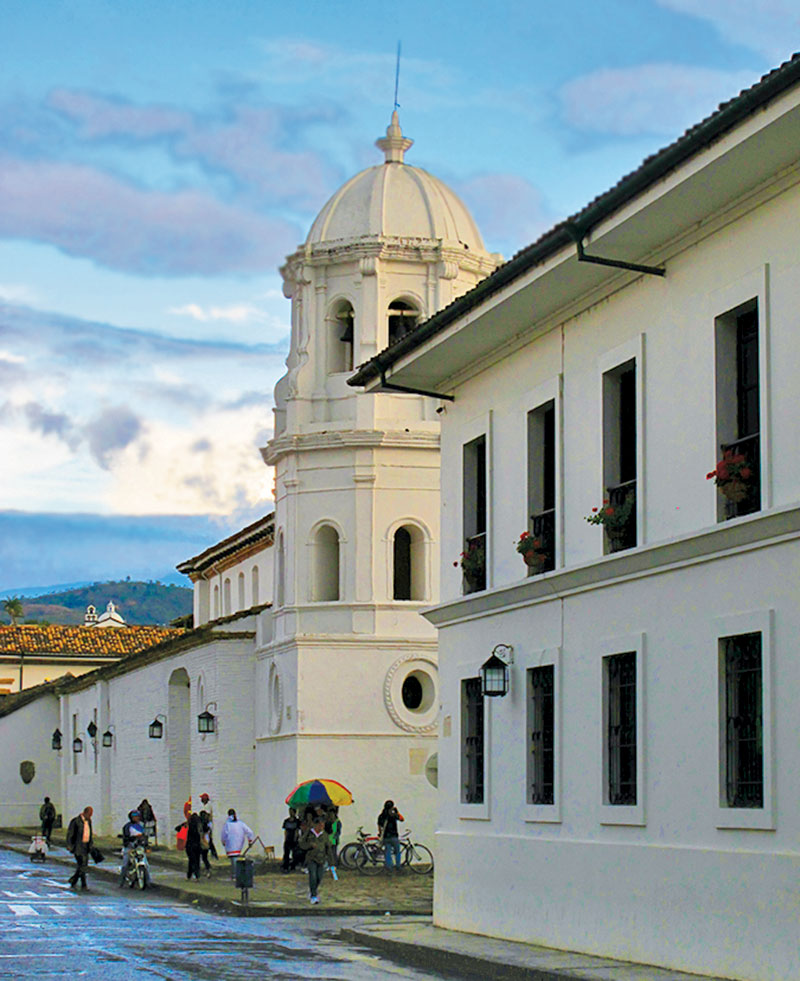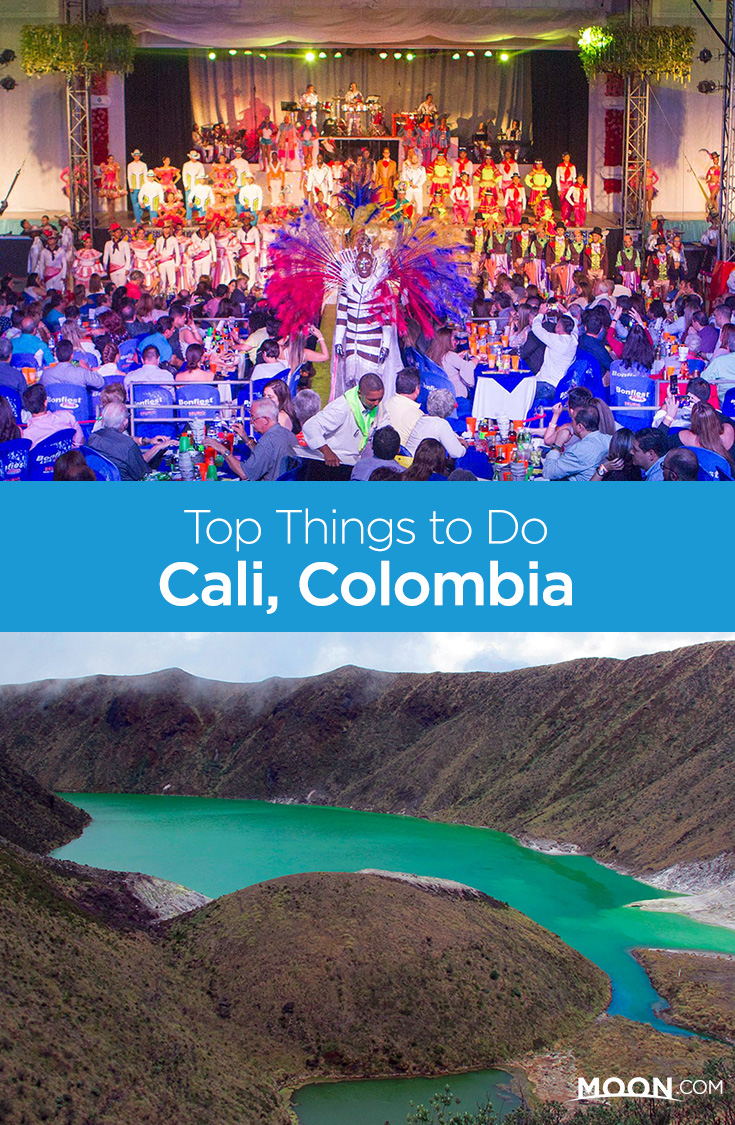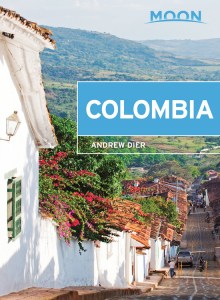Top Things to Do in Cali, Colombia
Hiking boots and dancing shoes are essential in southwestern Colombia, an unsung destination chock full of natural adventures. From salsa (both doing and watching) to exploring colonial architecture to trekking around a lake in a volcano’s crater, here are the top things to do in Cali, Colombia.
Salsa in Cali
In Cali, there are many ways you can experience (and very likely get hooked on) salsa.
On the first Saturday night of the month, go to Salsa al Parque (4pm-midnight, free, fculturalatina@gmail.com). This friendly and open-air freebie, held in different areas of the city, is known as an audición, which is a chance for coleccionistas, enthusiasts who collect salsa albums, to play their favorites for the crowd. People young and old, and visitors and locals from all walks of life, gather for these events, with the common denominator being a love of salsa. The event is organized by the Fundación Cultural Nuestra Cosa Latina; check its Facebook page to see what it has planned.

Salsotecas
No matter where you go on a Saturday night, there’s a good chance that you’ll hear some salsa. But there are some places—salsotecas—where it’s all about salsa and nothing more. Most are open from Wednesday until Sunday, closing at around 2am. Big salsotecas, like Tin Tin Deo (Cl. 5 No. 38-71, tel. 2/514-1537, 8pm-3am Thurs.-Sat., cover COP$15,000, with ladies usually getting a discount), will have a cover. Many of the famous spots are in the south of the city, clustered along Calle 5. While two women dancing together is generally accepted, two men together may not be; however, some places, such as La Topa Tolondra (Cl. 5 No. 13-27, cell tel. 314/664-1470, 6pm-1am Wed.-Thurs., 6pm-3am Fri.-Sat., COP$10,000), are pretty open-minded.
Other recommended places to check out are: Punto Baré (Cl. 5 No. 13-15, cell tel. 316/446-4544, 9pm-2am Wed.-Thurs. and Sun., 9pm-4am Fri.-Sat.); Zaperoco Bar (Av. 5N No. 16-46, tel. 2/661-2040, 8pm-3am Thurs.-Sat., cover COP$20,000); Cuba Libre, the house band at Rincón Don Heberth (Cra. 24 No. 5-32 Local 6, cell tel. 310/409-7229); and The Casa Latina (Cl. 7 No. 27-38, tel. 2/556-6549, cell tel. 316/555-0412, no cover).

Salsa Shows
A number of flashy (and pricey) salsa shows take place in Cali, during which you can sit back in amazement (and vicarious exhaustion) at the fast and fancy footwork of the salsa dance troupes. The talented and high-energy dancers range in age from 4 to 40. Shows sell out quickly, so reserve a week or two in advance.
Delirio (Centro de Eventos Valle de Pacífico, Cra. 26 No. 12-328, tel. 2/893-7680, COP$190,000) is a sort of Cirque du Soleil—a la Cali—that combines dance, music, and circus, and it has delighted audiences all over the world. The group is constantly updating its shows, creating segments on different themes that inspire them (for instance, a Michael Jackson tribute). During intermission, audience members are invited to dance on stage. Performances go from about 8pm to well after midnight, and are generally held Fridays between April and December. Minors under the age of 18 are not allowed inside the big tent.
Another popular ongoing show is Ensálsate (cell tel. 313/585-7616, COP$120,000), which takes place the second Friday of each month and during the Feria de Cali at the Salón Ritz of the Hotel Dann Carlton (Cra. 2 No. 1-60, tel. 2/893-3000). It’s a three-act show with a mix of music and dance, with salsa, music from the Caribbean, tango, and even some hip-hop added to the mix. Tickets can be obtained at Tu Boleta.

Centro Histórico in Popayán
The temperate capital of the Cauca department, Popayán is known as the White City. It is a dignified city, proud of its place in history as the home of presidents, poets, and priests. It retains some colonial charm despite earthquakes and modernization. One of the most enjoyable things to do in Popayán’s is to amble along its beautiful historic center.
Museums abound in Centro Histórico, and feature heavily on Colombian art and nature.
- The Casa Museo Edgar Negret and Museo Iberoamericano de Arte Moderno de Popayán—MIAMP (Cl. 5 No. 10-23, tel. 2/824-4546, 8am-noon and 2pm-6pm Wed.- Mon., COP$2,500) is in the home of Edgar Negret, a Colombian artist best known for massive abstract iron sculptures that adorn public spaces in cities throughout Colombia and museums throughout the world.
- The Museo de Historia Natural de la Universidad del Cauca (Cra. 2 No. 1A-25, tel. 2/820-9861, 9am-noon and 2pm-5pm daily, COP$2,000) was founded in 1936 and highlights the astounding variety of species, both plant and animal, that are found in Colombia.
- Museo Nacional Guillermo Valencia (Cra. 6 No. 2-69, tel. 2/820-6160, 10am-noon and 2pm-5pm Tues.-Sun., COP$2,000) is an 18th-century house near the Puente del Humilladero that was the home of Popayán poet Guillermo Valencia.
- The Museo de Arte Religioso (Cl. 4 No. 4-56, tel. 2/824-2759, 8am-noon and 2pm-6pm Mon.-Fri., 9am-2pm Sat., COP$6,000) has 10 rooms of religious art from the colonial era in an 18th-century neoclassical house covering Quiteño, Popayán, and Spanish styles.
There are several colonial churches dating from the 17th to 18th centuries to visit in Popayán. Most of them have been restored following earthquakes over the years.
- The Iglesia San Francisco (Cl. 4 and Cra. 9, tel. 2/824-0160) is one of the most beautiful churches and dates to the late 18th century. You can ask at the church to see the mummies that were found here following the earthquake.
- The Iglesia La Ermita (Cl. 5 and Cra. 2, tel. 2/820-9725) is older, dating to the 16th century. It has some fine woodcarvings and paintings.
- The Iglesia Santo Domingo (Cl. 4 and Cra. 5, tel. 2/824-0536) is where the Good Friday procession begins every year.
- The neoclassical cathedral (Cl. 5 and Cra. 6, tel. 2/824-1710) on the Parque Caldas was completed in the early 20th century. The cathedral’s official name is Catedral Basílica de Nuestra Señora de la Asunción de Popayán, but it is always referred to as “la catedral.”
Tierradentro
The Tierradentro Archaeological Park (91 km east of Popayán, 8am-4pm daily, COP$20,000) comprises five sites spread across four hills, straddling Vía San Andrés de Pisimbalá-El Crucero. This is the site of a major indigenous necropolis that includes monumental funeral statues and hypogea (underground burial chambers). These chambers, some 12 meters wide, are decorated with intricate red and black anthropomorphic and zoomorphic geometric designs, some of which are in relief. They were first excavated and studied in the 1930s. This archaeological park was declared a UNESCO World Heritage Site in 1995.
These awe-inspiring burial chambers, believed to have been built between AD 600 and AD 900, reveal the existence of a rich and complex society that devoted significant time and effort to preparing the way to the afterlife. There is also an intriguing symmetry to be found between these ornate underground chambers and the houses of the living above ground. A high-quality flashlight is a must for getting a good look at the interior paintings of the tombs and some of the elaborate artwork decorating them.

San Agustín
The small colonial town of San Agustín, nestled within the folds of the southern Colombian Andes and west of the Río Magdalena, would probably be an attractive destination in its own right. At an elevation of 1,800 meters (5,900 feet), it is set in a place of enormous natural beauty and has wonderful springlike weather. However, its fame comes from its location near the largest pre-Columbian archaeological site south of Central America and north of Perú.
The excellent Parque Arqueológico de San Agustín (San Agustín Archaeological Park, 8am-4pm daily, COP$20,000) covers 80 hectares (200 acres) of what was one of the most important ritual areas of the San Agustín culture. Some 130 kilometers (80 miles) southeast of Popayán, it was established in 1937 and declared a UNESCO World Heritage Site in 1995. The park contains over 130 statues with striking human and animal-like features, as well as carved tombs and monumental stone tables, or dolmens. The park is easy to navigate: Plan on a couple of hours to stroll it at leisure and absorb the beauty. The park is two kilometers (1.25 miles) west of the town of San Agustín and can be reached on foot or by bus. A ticket here is also valid at the Parque Arqueológico Alto de los Ídolos.
Near the entrance to the park is the highly recommended Museo Arqueológico (free). It contains pottery, tools, jewelry, and some smaller-scale statues. It’s a good educational stop to learn more about the San Agustín culture before visiting the sites themselves.
Don’t rush your stay in San Agustín, as it is a pleasant and peaceful place to visit, with several options for hiking and rafting amid spectacular mountain landscapes. This little town has surprisingly good restaurants and accommodations.
Laguna La Cocha
The lakeside fishing village of Encano, on the shores of Laguna La Cocha, is home to about 200 families who mostly make their living as trout farmers. The cheerfully painted wooden A-frames, the flower boxes, and the colorful lanchas (wooden boats) waiting at the ready will remind you of someplace—but probably not Colombia! There are many simple restaurants in Encano, all specializing in La Cocha trout, served in a multitude of ways.
From Encano, you can hire a boat to take you to the sanctuary on tiny Isla de la Corota, not far away (about a 10-minute ride). It’s a lovely excursion, one that won’t take long: The island covers only about 16 hectares (40 acres) of land. This excursion costs about COP$25,000 per boat; the boat’s owner will wait for you and take you back to the mainland. On the island, you’ll have to pay an entry fee (COP$1,000) and sign in at the ranger station. From there you’ll walk through the virgin rainforest on a wooden walkway. Although the vegetation is tropical, with 500 species of plants including ferns, bromeliads, orchids, lichen, and siete cueros trees, the climate is actually quite cool. It’s nice to go on a weekday when there are few visitors, so that you can enjoy the wonderful peace that the island brings.
Surrounding the lake are more than 50 private natural reserves managed by local farmers through the Asociación de Desarollo Campesino. Many of these offer accommodations for visitors. One such reserve is El Encanto Andino (Vereda Santa Teresita, cell tel. 321/263-2663 or 311/634-7635, COP$65,000 pp including meals; transportation COP$70,000 per group). Here you can take walks through the jungle, visit an orchid farm, and do some bird-watching, among other activities. Food is produced at the reserve, and it is all organic. To get to this peaceful spot, you’ll have to take a boat across the lake, but the reserve will make those arrangements for you. You can also visit as a day trip.

Laguna Verde
The hike up to the sulfurous Laguna Verde (3,800 meters/12,500 feet), a dazzling, emerald-green crater lake on the north side of the dormant Volcán Azufral, is easy to make from Pasto. A sacred site for the Pasto indigenous people, the volcano is part of the Nudo de los Pastos mountain range, which serves as a natural border between Colombia and Ecuador. The vegetation in the páramo (highland moor) is sparse, with low shrubs, wildflowers, moss, and lichen. There is little fauna to be seen, except for the occasional gavilan
(vulture) gliding through the air. From here on a clear day you can see as far as the Galeras volcano in Pasto.
The Reserva Natural Azufral is managed by a community organization, the Asociación Azufral los Andariegos Túquerres (Cra. 6A No. 16D-50, tel. 2/730-8955, cell tel. 316/713-3823). From the park’s ranger cabin, it is a six-kilometer (3.7-mile) hike to Laguna Verde and Laguna Negra. Hikers are requested to register at the cabin and pay a small entry fee (COP$2,000). It is an easy, gradual ascent as the path follows a dirt road all the way up the mountain. This can take 3-5 hours. It is hard to get lost, especially on weekends and holidays when there are many fellow hikers.

Related Travel Guide
Pin For Later

